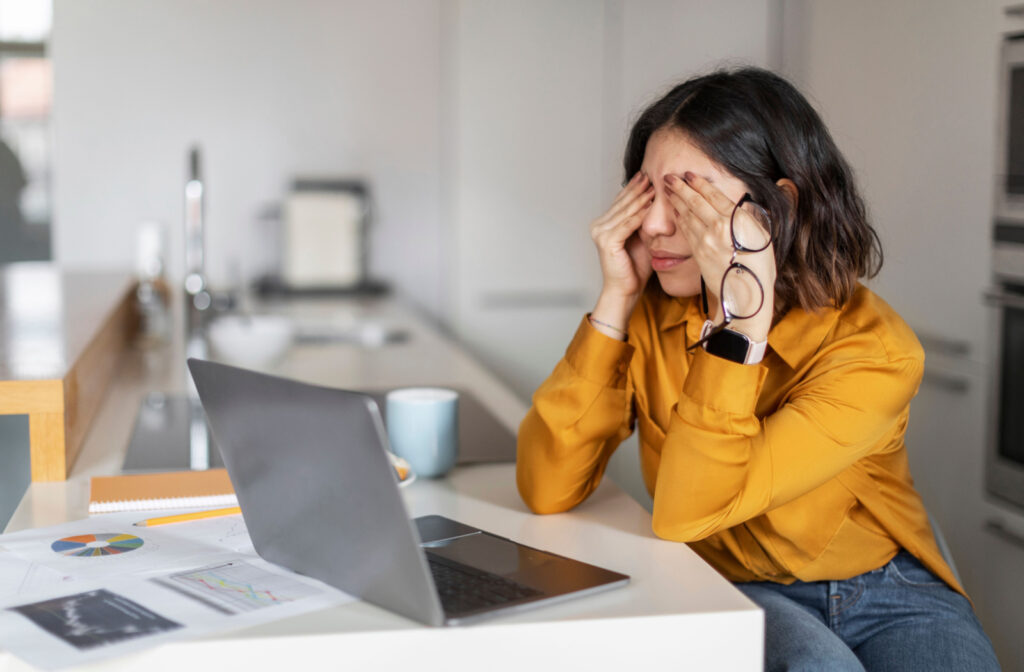Experiencing eye strain is akin to a nagging reminder of the countless hours you spend staring at screens or intensely focusing on intricate tasks. It can manifest as a temporary discomfort, but how long does this sensation tend to linger?
Eye strain can persist until you address the conditions causing it—whether it’s not taking enough breaks, having poor posture, or wearing glasses with an outdated prescription. Once you remedy eye strain triggers, you can start to feel more comfortable.
What Is Eye Strain?
Eye strain arises when your eyes get tired from intense use. It is a common condition in today’s digital era with symptoms including:
- Sore or irritated eyes
- Difficulty focusing
- Dryness
- Excessive tearing
Its causes are multifaceted, spanning from:
- Prolonged screen time
- Exposure to bright light
- Strain from reading without adequate lighting
- Not blinking enough
- Stress
- Fatigue
Understanding the Duration of Eye Strain
The duration of eye strain drastically varies based on several factors, such as visual health, environment, and habits. Typically, symptoms of eye strain may last anywhere from a few minutes to several hours after a stress-inducing activity.
If symptoms persist beyond this point, it is a potential signal that another underlying eye condition could be at play, and you should visit your optometrist.
Factors That Influence the Duration
The duration of eye strain can depend on:
- How long you have been engaged in the strenuous visual task.
- The light conditions in your environment, with poor lighting often exacerbating symptoms.
- The distance and angle to the visual task, as improper screen positioning can contribute to prolonged strain.
- Pre-existing eye issues or uncorrected vision problems can significantly affect the presence and persistence of eye strain.
When to Seek Help from Your Optometrist
While occasional eye strain is expected, frequent or prolonged discomfort should not be overlooked. It’s crucial to consult with an eye care professional when:
- Symptoms persist despite taking breaks or adjusting habits
- Visual changes or pain accompanies the eye strain
- The eye strain starts to interfere with daily activities
Eye Strain in Children
With increased online learning and reliance on screens for school and play, digital eye strain can affect young kids. Children with eye strain can experience similar symptoms as adults, but they may also display behavioural cues, including:
- Complaining of tired eyes
- Rubbing eyes
- Squinting
- Trouble sleeping
Encouraging children to take breaks, spend time outdoors, and limit screen time to at least 1 hour before bed is becoming increasingly important alongside children’s eye exams.
Best Practices for Preventing Eye Strain
Implement the following tactics to help keep your eyes refreshingly strain-free:
- Follow the 20-20-20 rule: Every 20 minutes, take a 20-second break to look at something 20 feet away.
- Get proper lighting: Adjust your environment to decrease glare and harsh reflections on screens.
- Take frequent breaks: Step away from your screen or books to give your eyes a deserved rest.
Effective Strategies for Managing Eye Strain Symptoms

For those times when prevention falls short, managing symptoms effectively is key.
- Use artificial tears: Dry eyes can intensify the feeling of strain. Over-the-counter lubricating eye drops can offer quick relief.
- Apply warm compresses: A warm towel over your eyes can relax the muscles and provide comfort.
- Adjust screen settings: Optimize your device’s brightness, contrast, and text size to lighten the load on your eyes.
Lifestyle Changes to Reduce Eye Strain Risk
Long-term lifestyle modifications can pay dividends for your visual well-being:
- Regular eye exams: Keeping up with ocular health checks can identify problems early.
- Proper ergonomics: Align your workstation to minimize strain and support good posture.
- Healthy diet: Nutrients like vitamins C and E, zinc, lutein, and omega-3 fatty acids promote eye health.
Professional Advice & Treatment Options
Sometimes, home remedies and self-management may not suffice, necessitating professional intervention.
Available Treatments & Therapies for Eye Strain
Upon consultation, your eye care professional might recommend treatments such as:
- Prescription eyewear tailored to reduce eye strain
- Vision therapy to strengthen ocular muscles
- Adjustments to your current eyeglass or contact lens prescriptions
Tips for Finding the Right Eyewear
Should corrective lenses be the road taken, consider the following:
- Anti-reflective coatings to cut down on glare
- Blue light filtering lenses if screens are central to your evenings
- Lenses designed for the specific activities causing strain
Treat Eye Strain to Relieve Symptoms
Tending to your eye strain is not merely about short-term symptom management; it is an investment in your long-term visual health. Familiarize yourself with the signs, take proactive steps to prevent strain, and consult the experts at Alcona Eye Care Centre. Knowing enables you to make informed choices about your ocular health. Schedule an eye exam to support your and your child’s eye health and healthy screen habits.





